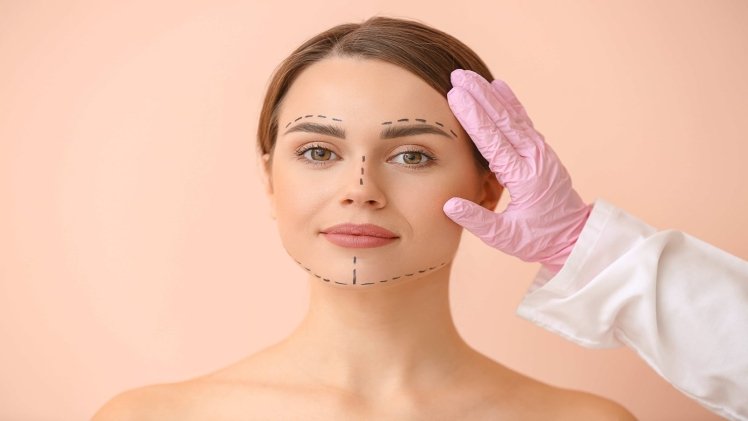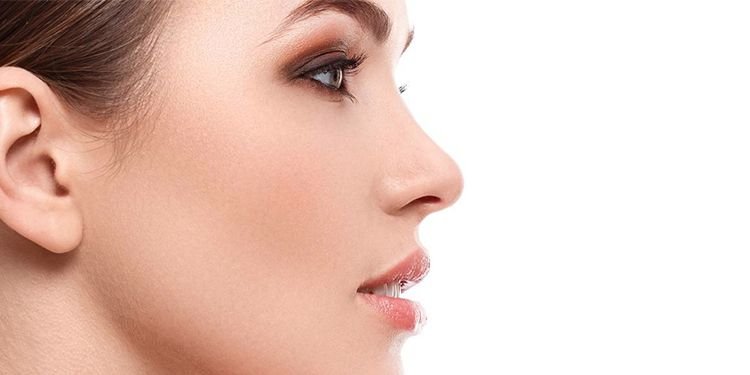Unveiling the Path to the Perfect Nose

In the realm of facial aesthetics, the quest for the perfect nose has captivated individuals for centuries. The nose, a central feature of the face, plays a pivotal role in determining one’s overall facial harmony and balance. The pursuit of this idealized nasal form has led to the development of various cosmetic procedures and surgical techniques. Rhinoplasty, commonly referred to as a “nose job,” has emerged as a transformative solution that aims to unveil the path to the perfect nose.
Aesthetic Rhinoplasty is an intricate surgical procedure that involves reshaping the nasal structure to achieve a more harmonious and balanced facial appearance. This procedure can address a wide array of concerns, ranging from correcting asymmetry and refining the nasal tip to adjusting the bridge’s height and straightening deviations. The approach to rhinoplasty has evolved over time, transitioning from traditional open techniques to more refined and minimally invasive approaches. Surgeons now emphasize a personalized approach, taking into account the individual’s unique facial features, ethnic background, and aesthetic goals. Through meticulous planning and advanced technology, surgeons strive to sculpt a nose that seamlessly complements the individual’s overall facial characteristics.
However, the pursuit of the perfect nose extends beyond surgical intervention. Non-surgical options, such as dermal fillers, have gained popularity for their ability to temporarily reshape and contour the nose without the need for invasive procedures. These fillers can be strategically placed to smooth out irregularities, add volume to specific areas, and enhance overall facial harmony. The non-permanent nature of these treatments allows individuals to experiment with different looks before committing to a permanent alteration. As technology and medical understanding continue to advance, the path to the perfect nose becomes increasingly multifaceted, offering a spectrum of choices tailored to each person’s preferences and needs.
In conclusion, the journey to the perfect nose is a dynamic and individualized process that encompasses both surgical and non-surgical options. Whether one chooses the transformative power of rhinoplasty or the temporary adjustments provided by dermal fillers, the ultimate goal is to harmonize the nasal proportions with the rest of the face. As medical techniques evolve and aesthetic ideals shift, the definition of the perfect nose remains subjective and unique to each person. With the guidance of skilled professionals and the empowerment of informed choices, individuals can navigate this path to discover the nose that truly embodies their desired facial aesthetic.
Understanding the Aesthetics of the Perfect Nose

The aesthetics of the perfect nose are a fascinating interplay of proportions, angles, and harmony that contribute to an individual’s overall facial beauty. The concept of a perfect nose is not universally standardized, as beauty ideals vary across cultures and eras. However, certain principles persistently guide the understanding of an aesthetically pleasing nose.
One of the fundamental aspects of a harmonious nose is its proportion to the rest of the face. The nose should neither dominate nor recede; it should complement and enhance the other facial features. The ideal nasal proportions typically involve a balance between the nasal length, width, and projection. A nasal bridge that aligns with the brow and smoothly transitions to the nasal tip is often considered attractive. The angle between the nasal bridge and the forehead, as well as the angle between the nasal bridge and the upper lip, contribute significantly to the overall aesthetics.
Moreover, the symmetry of the nose is a critical factor in its perceived beauty. Asymmetries, even minor ones, can draw attention away from the facial harmony. A perfectly symmetrical nose, however, is not always necessary. Some degree of natural asymmetry is common and can contribute to an authentic appearance. Skilled surgeons take these subtle imbalances into account when performing rhinoplasty, aiming to enhance symmetry while preserving the individual’s unique characteristics.
The nasal tip also plays a pivotal role in defining the aesthetics of the perfect nose. A well-proportioned, refined, and slightly upturned tip is often favored. The tip’s angle, rotation, and projection contribute to the overall impression of youthfulness, attractiveness, and balance. Nevertheless, it’s important to emphasize that the concept of the perfect nose is subjective and can differ significantly from person to person. Cultural influences, personal preferences, and individual facial features all play a role in shaping one’s perception of an ideal nose. As the field of aesthetics continues to evolve, the understanding of the perfect nose remains a dynamic and nuanced exploration of the interplay between science, art, and personal expression.
The Role of Genetics in Shaping Your Ideal Nasal Profile
Genetics play a substantial role in shaping an individual’s ideal nasal profile. The characteristics of the nose, including its size, shape, and proportions, are strongly influenced by the genetic makeup inherited from one’s parents and ancestors. These genetic factors establish the foundation upon which an individual’s nasal profile develops. As a result, family traits can be observed in the nasal features passed down through generations.
The interplay of genetic factors determines the basic structure of the nose, such as the width of the nasal bridge, the length of the nasal tip, and the overall shape. An individual’s ethnic background also significantly contributes to the nasal characteristics they inherit. Different populations possess distinct nasal traits that have evolved over generations as adaptations to various climates and environmental conditions. For instance, individuals of African, Asian, European, or Indigenous descent tend to exhibit varying nasal shapes and structures.
While genetics provide the starting point, the interaction between genetic predisposition and external factors can further influence the development of the ideal nasal profile. Environmental factors like diet, exposure to pollutants, and lifestyle habits can impact the growth and appearance of the nose over time. Furthermore, the aging process can alter the nasal structure, leading to changes in shape and volume. Understanding the role of genetics in shaping the ideal nasal profile underscores the unique attributes that each individual brings to their aesthetic journey. Whether considering surgical interventions, non-surgical enhancements, or embracing natural features, recognizing the genetic foundation of the nasal profile is a key aspect of achieving harmonious facial aesthetics.
Exploring Surgical and Non-Surgical Options for Nose Refinement

Exploring the options for nose refinement opens a world of possibilities, ranging from surgical procedures to non-surgical interventions. Surgical and non-surgical methods cater to different needs and preferences, offering individuals the flexibility to choose the approach that aligns with their aesthetic goals and comfort level.
Surgical options, most notably rhinoplasty, have long been the go-to solution for those seeking significant and lasting changes to their nasal appearance. Rhinoplasty involves reshaping the bone, cartilage, and tissue of the nose to achieve desired proportions and contours. This procedure is tailored to the individual’s unique facial structure and can address a wide array of concerns, from reducing a prominent nasal hump to refining the tip’s shape. Advanced surgical techniques, such as open and closed rhinoplasty, allow for precision and customization, ensuring that the end result harmonizes with the rest of the face.
On the other hand, non-surgical options offer an attractive alternative for individuals seeking more subtle changes or those who are hesitant to undergo surgery. Dermal fillers, such as hyaluronic acid-based injectables, provide a non-permanent way to enhance the nose’s appearance. By strategically placing fillers in areas of asymmetry or imbalance, a skilled practitioner can achieve effects like smoothing out bumps, adding volume to the bridge, or lifting the tip. Non-surgical nose refinement requires minimal downtime and often appeals to individuals who wish to experiment with different looks before committing to a permanent alteration.
Ultimately, the choice between surgical and non-surgical options depends on an individual’s goals, preferences, and desired level of change. Consulting with a qualified and experienced medical professional is essential to determine the most suitable approach for achieving the ideal nose refinement. Whether opting for the precision of surgery or the versatility of non-surgical interventions, individuals have the opportunity to sculpt their nasal profile in a way that complements their natural beauty and enhances their overall facial aesthetics.
Harmonizing Your Features: Customized Approaches to Nasal Enhancement
Harmonizing one’s facial features through customized approaches to nasal enhancement is at the heart of modern aesthetic practice. Recognizing that every individual possesses a unique combination of facial characteristics, medical professionals now emphasize the importance of tailoring nasal enhancement techniques to suit each person’s distinct needs and aspirations.
Customization in nasal enhancement involves a comprehensive assessment of an individual’s facial proportions, bone structure, skin type, and overall aesthetic goals. This approach ensures that any alterations made to the nose are in harmony with the surrounding features, contributing to a balanced and natural appearance. Skilled surgeons and practitioners consider not only the anatomical elements but also the individual’s cultural background and personal preferences. This personalized approach is particularly crucial for achieving results that resonate with the patient’s sense of identity and beauty ideals.
Advances in technology, such as 3D imaging and simulation tools, have transformed the consultation process by enabling individuals to visualize the potential outcomes of various enhancements. These tools facilitate open communication between the patient and the practitioner, fostering a collaborative decision-making process. Customized nasal enhancement can involve surgical techniques, like precise cartilage sculpting, or non-surgical procedures, such as targeted filler injections. The goal is to refine the nasal profile in a way that accentuates the person’s unique attributes and cultivates a sense of confidence that radiates from within. By embracing customized approaches to nasal enhancement, individuals can embark on a transformative journey that honors their individuality while achieving facial harmony and aesthetic fulfillment.
Consulting with Experts: Your First Step towards Nose Transformation

Embarking on a nose transformation journey begins with a crucial step: consulting with experts who specialize in facial aesthetics and nasal procedures. Seeking professional guidance is essential to ensure a comprehensive understanding of the available options, potential outcomes, and the personalized approach that will best suit individual goals and features.
When considering a nose transformation, scheduling a consultation with a board-certified plastic surgeon or a skilled medical practitioner with expertise in rhinoplasty and facial enhancements is paramount. During the consultation, you’ll have the opportunity to discuss your concerns, aspirations, and any specific features you’d like to enhance or refine. An experienced professional will perform a thorough assessment of your facial anatomy, nasal structure, skin quality, and overall facial harmony. This evaluation enables them to provide you with personalized recommendations and a detailed understanding of how different approaches could enhance your appearance.
Consulting with an expert also involves an open and honest discussion about the available surgical and non-surgical options. Your practitioner should explain the potential risks, benefits, and limitations of each approach, allowing you to make an informed decision. They might also use advanced imaging tools and simulations to help you visualize the potential results of different treatments. This collaborative process empowers you to actively participate in designing a transformation plan that aligns with your desired outcomes, budget, and comfort level.
In conclusion, the journey towards a nose transformation begins with consulting professionals who specialize in facial aesthetics. Their expertise, insights, and personalized approach will guide you through the myriad options available, helping you make informed decisions that lead to outcomes that resonate with your aesthetic goals and celebrate your unique features.
Empowerment through Choice: Making Informed Decisions about Rhinoplasty
Empowerment lies at the core of the decision-making process when it comes to rhinoplasty, allowing individuals to take control of their appearance and boost their self-confidence. Making informed decisions about rhinoplasty involves a combination of thorough research, thoughtful self-reflection, and open communication with a qualified medical professional. This process ensures that individuals are equipped with the knowledge and confidence to shape their ideal nasal profile.
Research plays a crucial role in understanding the nuances of rhinoplasty. By exploring various aspects of the procedure, including techniques, potential risks, recovery timelines, and expected outcomes, individuals can develop a realistic perspective of what the process entails. Online resources, peer-reviewed articles, and patient testimonials can provide valuable insights into the experiences of others who have undergone similar transformations. However, it’s important to approach online information critically and verify the credibility of sources.
Equally important is self-reflection, which involves identifying the specific aspects of one’s nose that cause concern and envisioning how changes could positively impact overall facial harmony. Taking the time to assess personal motivations and aesthetic goals is essential to articulate clear expectations for the procedure. It’s worth noting that rhinoplasty is a transformative journey that extends beyond the physical changes, influencing emotions, self-esteem, and self-perception.
Engaging in open communication with a qualified plastic surgeon or medical practitioner specializing in rhinoplasty is the cornerstone of making an informed decision. During consultations, individuals can share their aspirations, ask questions, and express any concerns. Skilled professionals will provide a detailed overview of potential outcomes, discuss surgical techniques, and use tools like computer simulations to visualize potential results. This collaborative dialogue ensures that individuals understand the feasibility of their desired changes and can realistically envision the transformation.
Ultimately, informed decisions about rhinoplasty empower individuals to pursue the changes they desire, enhancing their self-confidence and overall well-being. By combining research, self-reflection, and open communication, individuals can confidently embark on their aesthetic journey, knowing that they have taken the necessary steps to shape their ideal nasal profile in alignment with their unique features and goals.
Maintaining Your Ideal Nasal Aesthetics for the Long Run

Maintaining your ideal nasal aesthetics for the long run involves a combination of diligent care, mindful lifestyle choices, and periodic follow-ups with your medical practitioner. Whether you’ve undergone rhinoplasty or opted for non-surgical enhancements, these practices will help ensure that your desired results remain vibrant and harmonious over time.
Post-operative care is crucial for individuals who have undergone rhinoplasty. Following your surgeon’s instructions regarding wound care, medication, and activity restrictions will facilitate proper healing and minimize the risk of complications. Engaging in activities that could impact your nose, such as sports or heavy lifting, should be avoided during the initial recovery period. Adhering to a healthy lifestyle that includes a balanced diet, regular exercise, and sufficient hydration will promote overall healing and skin vitality, contributing to the longevity of your aesthetic outcome.
For those who have chosen non-surgical interventions, understanding the temporary nature of treatments like dermal fillers is essential. While these solutions offer flexibility and minimal downtime, they require maintenance to sustain the desired effects. Depending on the specific product used, fillers may last from several months to a couple of years. Scheduling regular follow-up appointments with your medical practitioner allows them to assess your progress, address any concerns, and recommend touch-up sessions as needed to maintain your desired nasal aesthetics.
Regardless of the chosen method, sun protection is a universal component of maintaining your ideal nasal aesthetics. UV radiation can accelerate the aging process and compromise skin quality, leading to diminished results. Applying broad-spectrum sunscreen and avoiding excessive sun exposure will help protect your skin’s integrity and preserve the youthful appearance of your nasal area.
In summary, long-term maintenance of your ideal nasal aesthetics involves a combination of attentive care, healthy lifestyle choices, and ongoing communication with your medical practitioner. By incorporating these practices into your routine, you can enjoy the benefits of your aesthetic transformation for years to come while ensuring that your nasal profile remains in harmony with your overall facial aesthetics.
Elevating Your Facial Harmony: The Transformative Power of Rhinoplasty
Rhinoplasty, a surgical procedure that reshapes and enhances the nose, holds the transformative power to elevate facial harmony and redefine one’s overall appearance. Beyond its physical impact, rhinoplasty often leads to an emotional transformation, boosting self-confidence and allowing individuals to present their best selves to the world.
The nose, positioned centrally on the face, has a remarkable influence on facial symmetry and balance. Rhinoplasty addresses a wide range of concerns, such as correcting a prominent hump, refining the nasal tip, adjusting the width of the bridge, or improving overall proportions. By harmonizing the nose with the surrounding features, rhinoplasty creates a balanced aesthetic that complements the unique beauty of each individual.
The transformative journey of rhinoplasty is more than just a physical change—it’s an emotional and psychological investment. Many individuals experience heightened self-esteem and a renewed sense of confidence as they see their facial harmony improved. This newfound confidence can extend beyond physical appearance, impacting social interactions, personal relationships, and even professional opportunities. By embracing the transformative power of rhinoplasty, individuals are empowered to shape their external image in a way that reflects their inner sense of self-assurance and beauty, ultimately leading to a more fulfilled and harmonious life.












